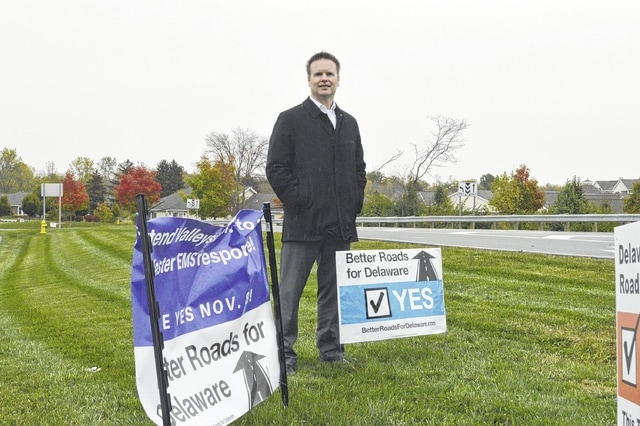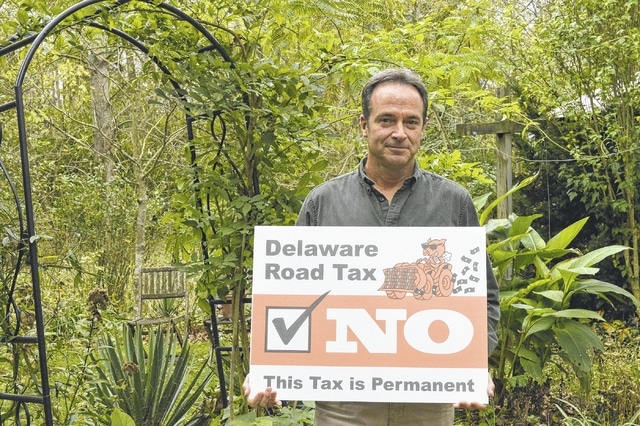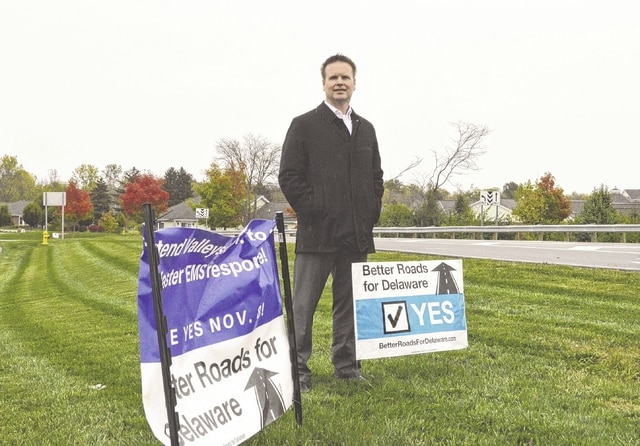


Delaware residents will decide on Nov. 8 if the city’s Moving Delaware Forward initiative warrants an increase of the income tax for street maintenance and infrastructure-related projects.
Road needs
City Council was reminded of the lack of dollars to maintain local streets when it worked on the budget each year, said Councilwoman Lisa Keller, 2nd Ward.
“What really initiated the discussion was the maintenance of the roads we already have and we have a critical situation that hopefully this levy will address,” she said during a work session for the five-year Capital Improvement Plan earlier this month.
The city’s roadway miles increased to 310 miles in 2015 compared with 203 in 1995. During the same period, signalized intersections increased to 61 from 36, while streets lights jumped to 1,800 from 100.
The construction of new roads has propped up the overall grade, according to city engineer/public works director Bill Ferrigno.
Sixteen percent of all city roads are in poor condition, according to a 2016 pavement rating report prepared by the city’s Department of Public Works, with 40 percent of local roads constructed before 1995 were in similar condition.
The recently approved CIP does not include levy dollars, indicating that the city will use available funding to accommodate scheduled paving for collector and arterial roads — that are more frequently used — leaving zero dollars for local street resurfacing.
Traffic congestion was another issue especially at The Point of the intersection of U.S. Route 36 and state Route 37. With two lanes going in opposite directions, the bottleneck becomes problematic during the morning and evening commutes.
“The majority of the traffic that leads to congestion is our local commuter traffic,” Ferrigno has said.
“Currently there’s 27,000 to 30,000 vehicles per day that run through (The Point and) that traffic is only going to increase as Delaware continues to grow.”
Trucks make up 6.5 to 8.5 percent of total traffic and less than 1 percent is from the Kroger Distribution facility on routes 37/36, he said.
Levy facts
City Council presented a formal solution to the city’s transportation system. Members met for a whole day to discuss the issues after a 2015 community survey identified that one out of four residents were dissatisfied with the condition of local streets, while half identified congestion as another problem.
Council placed the levy on the ballot in August after four readings and three public hearings. Since May, city staff including its manager Homan have made rounds to several neighborhoods to provide information about the initiative.
If approved, the income tax would increase to 2 percent from 1.85 percent in January, which would cost a family with a $50,000 household income about $6 per month, or $75 per year.
While 1 percent of the current income tax goes to the general fund, 0.7 percent goes to fire and emergency medical services and 0.15 percent goes to a recreation levy that will expire in about a decade.
The additional 0.15 percent would generate $2.2 million annually, according to officials, and would solely complement what the city already spends on street maintenance and infrastructure projects. Delaware’s local government will spend about $3.8 million this year using funds from the gasoline tax, license fees and the general fund income tax, which alone contributes about $1.92 million.
The initiative presented brings 15 years of study and planning from the city, county, state and regional agencies, according to the city.
In addition, Delaware has more than 50 priority projects as part of Moving Delaware Forward including nine publicized that alone have a total project cost of $46.25 million. Among them includes a $23 million project for The Point that would establish a four-lane capacity below a new railway structure, including pedestrian access on both sides of the road.
Ferrigno has said that proposed improvements for The Point are the “crown jewel” of the initiative’s identified priority projects. The project would cost about $5 million in local investment and take about five years to complete, he said, while a bypass would require $15 million in local investment and take 15 to 20 years to complete.
Also, Homan has said at meetings that property owners heavily opposed the bypass in the late 1990s when council favored such a project. Though city leaders do not support a bypass at this point, it’s an active part of the transportation plan and officials continue to seek sponsorship of the project.
Levy supporters
In late July, a political action committee was formed to support the levy on behalf of the city, which legally can’t on its own. The citizen-led Better Roads for Delaware has utilized social media and campaign signs to bring awareness and support for the ballot issue.
“If they like driving on the roads, they should vote ‘yes,’” Jim Browning said in August. “It’s that simple.”
Browning, who co-chairs the committee with Stephanie Steinbeck, said it has spent $6,000 for the campaign including 500 signs, postcards and 5,000 flyers.
Browning said there are some rough spots on his street, Hawthorn Boulevard. He trusts the city officials such as Ferrigno and city manager Tom Homan with the levy money.
“It’s a pretty good collection of folks,” he said.
Browning said he was frustrated that some levy opponents decided to get involve with four to six weeks until the election rather than voicing concerns earlier this year at City Council meetings.
“You got to put something into it,” he said.
The ballot has gained endorsements from local organizations such as the Delaware Area Chamber of Commerce, Main Street Delaware and The Gazette.
In a post on Facebook, the chamber stated: “Projects vital to resolving traffic congestion cannot go forward at current funding levels… The kind of economic growth that the city has experienced is both the good news and the other news. The increased need for attention to schools, social services and infrastructure cannot be overlooked as the benefits of a healthy local economy are enjoyed.”
Levy opponent
Not all are in favor of the levy. Delaware resident Mike West of Chatham Lane voiced his opposition at a public hearing on the levy in July. Since September, the freelance graphic designer started a “Vote No Delaware Road Tax Increase” campaign. As of last Monday, he’s spent nearly $900 on 3,000 campaign door hangars and 50 signs.
“I’m just one person doing this,” he said.
West originally opposed the initiative because the $5 million Valleyside Drive Extension, one of the nine priority projects, which links William Street and Central Avenue by connecting Valleyside and Lexington Boulevard. The new extension would pass by the Chatham Lane subdivision and remove some of the woodland area. Residents in that area believed that area was protected, said West, who’s lived in Delaware since 1996.
He created a Facebook page for his campaign as a forum about the issue and has done research about the congestion and traffic issues.
“This has been like a learning journey for me,” he said. Even if Valleyside Drive Extension project was not included, West would still oppose the levy.
“Knowing what I now know, I still vote no,” he said.
“It kind of bothers me that it’s happening fast.”
West said there should be more of a back and forth process between council and its constituents on how to maintain and improve local infrastructure. He said the city is putting all of its eggs in one basket with the levy.
West would rather see the city approach the issue on a project-by-project basis and resurface roads using a “maintenance levy” for a fixed amount of time instead of being permanent.
While he’s resigned to the reality that the levy will pass, West hopes the city will come back with another proposal next year if it’s struck down.
“I think the failure would be not to challenge this,” he said.
City responds
Councilman Kyle Rohrer, 4th-Ward, said he understands the concerns of Chatham Lane residents about the Valleyside Drive Extension project because no one wants a construction project to occur in their backyard.
But he said voting yes on the levy does not rubber stamp any of the more than 50 projects including Valleyside. Council would still need to approve each project.
Also, the Valleyside Drive project would reduce emergency response time by 2.24 minutes and reduce travel by a mile, city officials said.
Additionally, a permanent levy made sense to continue maintaining roads, Councilman Chris Jones, 1st-Ward, said.
“Maintaining a transportation network is ongoing, requiring continuous and expanding maintenance and permanent resources. Certain projects — fixing an intersection, for example — have fixed costs,” he said in an email. “Others — street resurfacing and traffic equipment — require annual effort for as long as the infrastructure is in use.”
“Annual revenue will advance and sustain that effort over time to ensure our transportation system keeps up with growth.”
Keller said council was faced with a critical decision about how to address issues of the city’s transportation system.
“No one likes to raises anyone’s taxes,” she said.
But with an estimated 40 public meetings to provide information about Moving Delaware Forward, Keller told The Gazette that levy opponents’ claims of the city bulldozing the levy through is “kind of shocking.”
Council meetings are usually not a packed house, she said, despite attempts to increase engagement such as live-streaming meetings on Youtube and posting information on the city’s website.
She said a road levy with an expiration date would simply hand the problem off to a future council, while putting a levy out for one priority project each year would be expensive and pointless.
Keller was among council members who have responded to general posts on social media about the road levy.
“I’m seeing a lot of chatter, you know, ‘oh wait for the next ask because the next time will go for a levy, assuming this one fails, it will be a better ask than this one was,” Keller said during the CIP work session meeting.
“I’m not really seeing us turning around and going back out again if this levy fails.”



